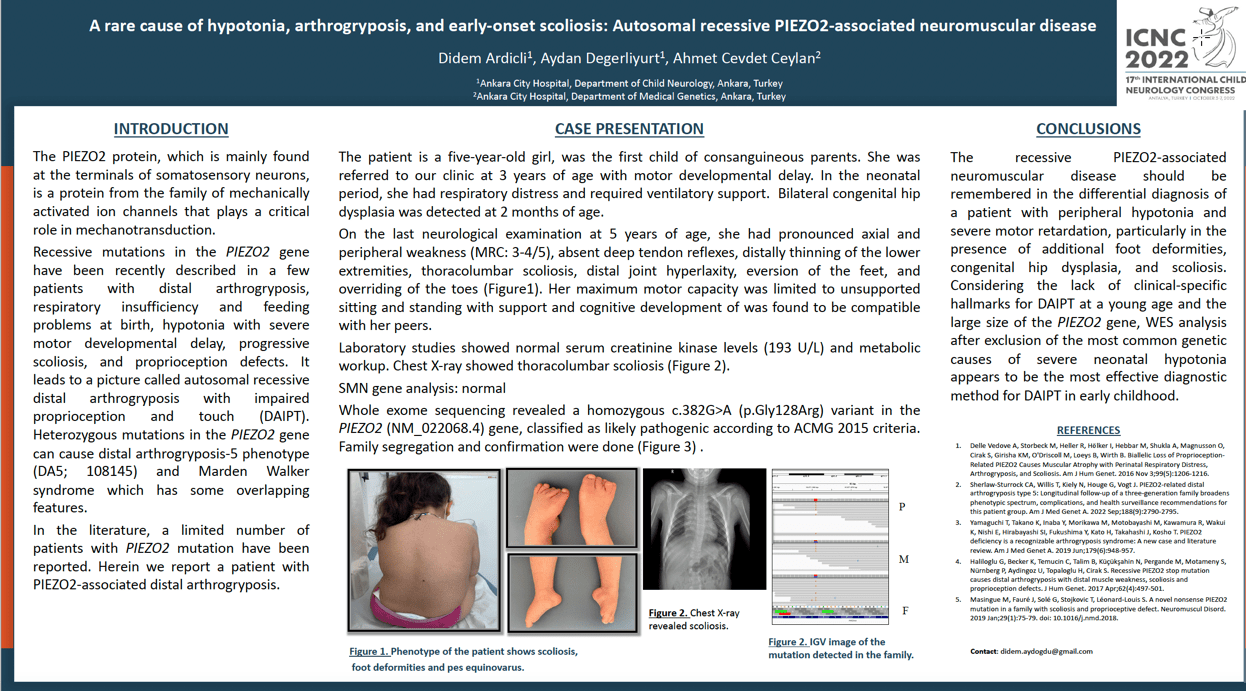A rare cause of hypotonia, arthrogryposis, and early-onset scoliosis: Autosomal recessive PIEZO2-associated neuromuscular disease
Didem Ardicli, Aydan Degerliyurt, Ahmet Cevdet Ceylan
Introduction: The PIEZO2 protein, which is mainly found at the terminals of somatosensory neurons, is a protein from the family of mechanically activated ion channels that plays a critical role in mechanotransduction. Recessive mutations in the PIEZO2 gene have been recently described in a few patients with distal arthrogryposis, respiratory insufficiency and feeding problems at birth, hypotonia with severe motor developmental delay, progressive scoliosis, and proprioception defects. It leads to a picture called autosomal recessive distal arthrogryposis with impaired proprioception and touch (DAIPT). Case presentation: A three-year-old girl with a history of perinatal respiratory distress and bilateral congenital hip dysplasia was presented with motor developmental delay. Neurological examination revealed axial and peripheral hypotonia, absent deep tendon reflexes, distally thinning of the lower extremities, thoracolumbar scoliosis, eversion of the feet, and overriding of the toes. While the maximum motor capacity was limited to unsupported sitting and standing with support, the cognitive development of the patient was found to be compatible with her peers. Laboratory studies revealed normal serum creatinine kinase levels and metabolic workup. The presence of homozygous c.382G>A (p.Gly128Arg) probable pathogenic variant in the PIEZO2 (NM-022068.4) gene was identified by whole-exome sequencing. Conclusion: The recessive PIEZO2-associated neuromuscular disease should be remembered in the differential diagnosis of a patient with peripheral hypotonia with severe motor retardation, arthrogryposis, congenital hip dysplasia, and scoliosis.
Keywords: hypotonia, arthrogryposis, scoliosis, proprioception defect, PIEZO2
Didem Ardicli
Turkey
Aydan Degerliyurt
Turkey
Ahmet Cevdet Ceylan
Turkey
Introduction: The PIEZO2 protein, which is mainly found at the terminals of somatosensory neurons, is a protein from the family of mechanically activated ion channels that plays a critical role in mechanotransduction. Recessive mutations in the PIEZO2 gene have been recently described in a few patients with distal arthrogryposis, respiratory insufficiency and feeding problems at birth, hypotonia with severe motor developmental delay, progressive scoliosis, and proprioception defects. It leads to a picture called autosomal recessive distal arthrogryposis with impaired proprioception and touch (DAIPT). Case presentation: A three-year-old girl with a history of perinatal respiratory distress and bilateral congenital hip dysplasia was presented with motor developmental delay. Neurological examination revealed axial and peripheral hypotonia, absent deep tendon reflexes, distally thinning of the lower extremities, thoracolumbar scoliosis, eversion of the feet, and overriding of the toes. While the maximum motor capacity was limited to unsupported sitting and standing with support, the cognitive development of the patient was found to be compatible with her peers. Laboratory studies revealed normal serum creatinine kinase levels and metabolic workup. The presence of homozygous c.382G>A (p.Gly128Arg) probable pathogenic variant in the PIEZO2 (NM-022068.4) gene was identified by whole-exome sequencing. Conclusion: The recessive PIEZO2-associated neuromuscular disease should be remembered in the differential diagnosis of a patient with peripheral hypotonia with severe motor retardation, arthrogryposis, congenital hip dysplasia, and scoliosis.
Keywords: hypotonia, arthrogryposis, scoliosis, proprioception defect, PIEZO2
Didem Ardicli
Turkey
Aydan Degerliyurt
Turkey
Ahmet Cevdet Ceylan
Turkey

Didem Ardicli
Turkey
Turkey